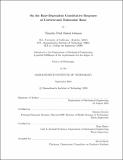On the rate-dependent constitutive response of cortical and trabecular bone
Author(s)
Johnson, Timothy Paul Mahal
DownloadFull printable version (27.55Mb)
Other Contributors
Massachusetts Institute of Technology. Dept. of Mechanical Engineering.
Advisor
Simona Socrate and Mary Boyce.
Terms of use
Metadata
Show full item recordAbstract
The widespread use of improvised explosive devices (IEDs) against American and coalition forces in the ongoing Iraqi and Afghani conflicts has caused a dramatic increase in the number of traumatic brain injury (TBI) cases seen in recent years. The skull acts as the first and primary line of defense for the brain. Researching this structure's protective capabilities and shortcomings is therefore critical to 1) understanding how blunt impact loads and blast waves are propagated through the skull and transmitted into the brain, and 2) improving and evaluating future combat protection systems. This doctoral study is aimed at mechanically characterizing and modeling the two major constituents of the skull: cortical and trabecular bone. The mechanical behavior of these two materials over a wide range of strain rates is identified through both a review of the existing literature data and our own experimental investigations. For the behavior of compact bone two separate viscoelastic rate-sensitivity regimes are identified and modeled with a Maxwell-Weichert model containing one linear elastic and two linear viscoelastic branches in parallel. The rate-dependent plasticity of the material is further shown to obey a simple power law relationship and the overall material behavior is captured in a generalized three-dimensional viscoelastic, viscoplastic constitutive model formulation. For validation, the three-dimensional constitutive model is implemented as a subroutine within a commercial nonlinear finite element program. Given the similar composition of both cortical bone and the solid portion of trabecular bone, the compact bone constitutive model is subsequently employed in modeling the trabeculae of cancellous bone within two complementary microstructural frameworks. The first approach utilized is to create three-dimensional solid bone models of trabecular architecture directly from micro computed tomography (CT) scans of cancellous bone biopsy samples. The original samples from which these micro CT scans were obtained are then tested experimentally and the resulting stress-strain curves are found to show excellent agreement with the micromechanical model predictions. Successful simulation of specimen loading was found to be contingent upon extracting the trabecular structure from micro CT data in such a way that matched the relative density of the resulting specimen mesh to the experimentally recorded value. Analysis of both the experimental and simulation results further demonstrates that 1) local distributions in strut relative density are highly influential in the determining the compressive strength of trabecular bone and 2) the formation of macroscopic, multi-strut shear bands is responsible for the initial plateau and post-yield softening exhibited by trabecular bone in uniaxial compression. 3 The second microstructural approach employed is to model the trabecular network with an idealized representative volume element (RVE) and apply periodic boundary conditions. This latter approach allows for rapid investigation of the effects of relative density and strain rate in determining trabecular bone's mechanical properties. Specifically, Young's modulus is found to vary in a nearly quadratic manner with relative density and compressive strength is shown to have a power law relationship to relative density with an exponent of 1.5. In addition, compressive strength is shown to have a power law dependence upon strain rate with an exponent of 0.055. These relationships and the magnitude of the values predicted are all found to closely match the experimental trends and values reported in the literature.
Description
Thesis (Ph. D.)--Massachusetts Institute of Technology, Dept. of Mechanical Engineering, 2010. This electronic version was submitted by the student author. The certified thesis is available in the Institute Archives and Special Collections. Cataloged from student-submitted PDF version of thesis. Includes bibliographical references (p. 163-172).
Date issued
2010Department
Massachusetts Institute of Technology. Department of Mechanical EngineeringPublisher
Massachusetts Institute of Technology
Keywords
Mechanical Engineering.